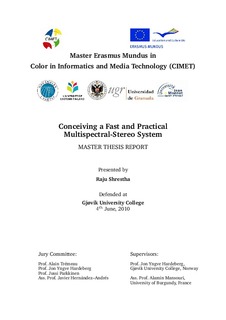| dc.description.abstract | Multispectral and 3D imagings are two complimentary imaging technologies with many advantages and great potential for their widespread use in the future, if we can make them faster and more practical. This thesis aims at conceiving such a fast and practical two-in-one stereo-multispectral system. Multispectral imaging systems remedy the problems of conventional three channel (RGB) color imaging like metamerism and dependency on acquisition conditions, and can at the same time present high spatial and spectral resolution. A multispectral image is composed of several monochannel images of the same object, each image holds data about a specific wavelength, or wavelength interval depending typically on the filter used. The major problems of existing multispectral imaging systems are that they are slow as they require multiple takes and/or they are quite expensive, contributing to the current lack of widespread use in the consumer segment. This thesis has explored creating a fast, practicable and affordable multispectral system with the use of two commercially available digital cameras. Each camera is equipped with an optical filter. These two filters are chosen so that they spread the sensitivities of the cameras in such a way that they become well spaced throughout the visible spectrum covering complementary wave-bands, thus giving rise to a six channel multispectral system. Like multispectral imaging, 3D imaging systems are also gaining popularity and are of much use in imaging fields. It would be a great advantage if we could have an integrated system capable of both multispectral and at the same time 3D imaging. This thesis, therefore, aims at this in conceiving such a stereo-multispectral system. The two cameras modified with appropriate filters that form a six channel multispectral system are used in a stereoscopic configurations to acquire depth information, making it capable of 3D imaging as well. This leads to a faster and practicable and at the same time affordable multispectral-stereo system. Both simulation and experimental results have shown that the proposed multispectral system results better estimation of the reflectances both spectrally and colorimetrically and that it is feasible. The 3D images are not much affected by the introduction of the filter(s) as is proved by comparable disparity maps computed out of them. Such a system could be used for many applications, for example for 3D artwork object acquisition. Knowing the spectral reflectance allows us to simulate the appearance of a 3D object under any virtual illuminant. Moreover, it lets us store this valuable information for future restoration. | en_US |
